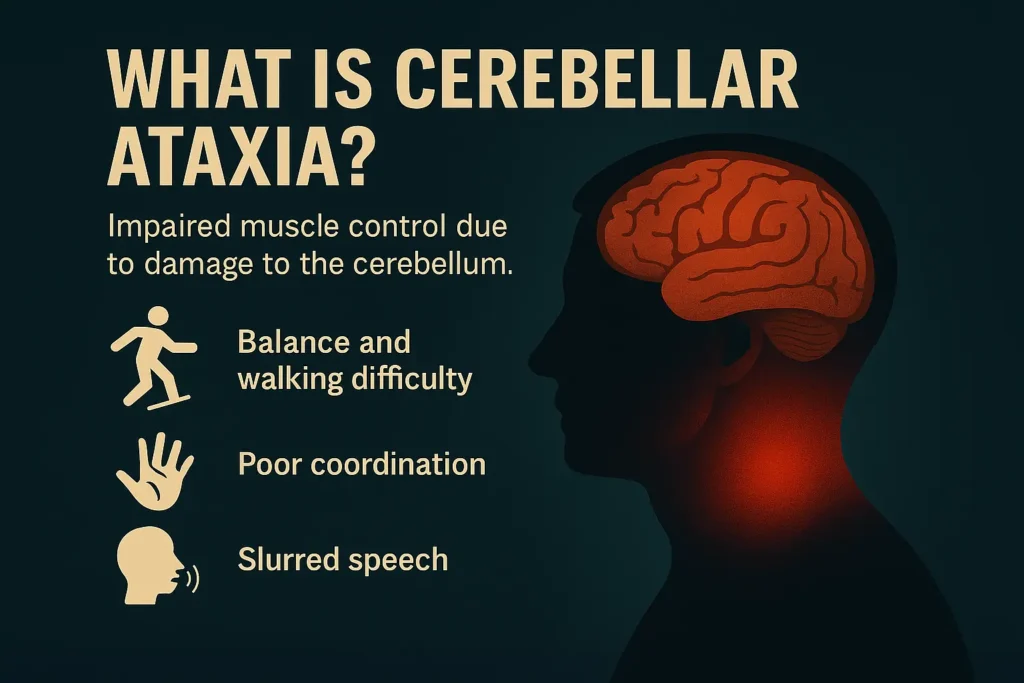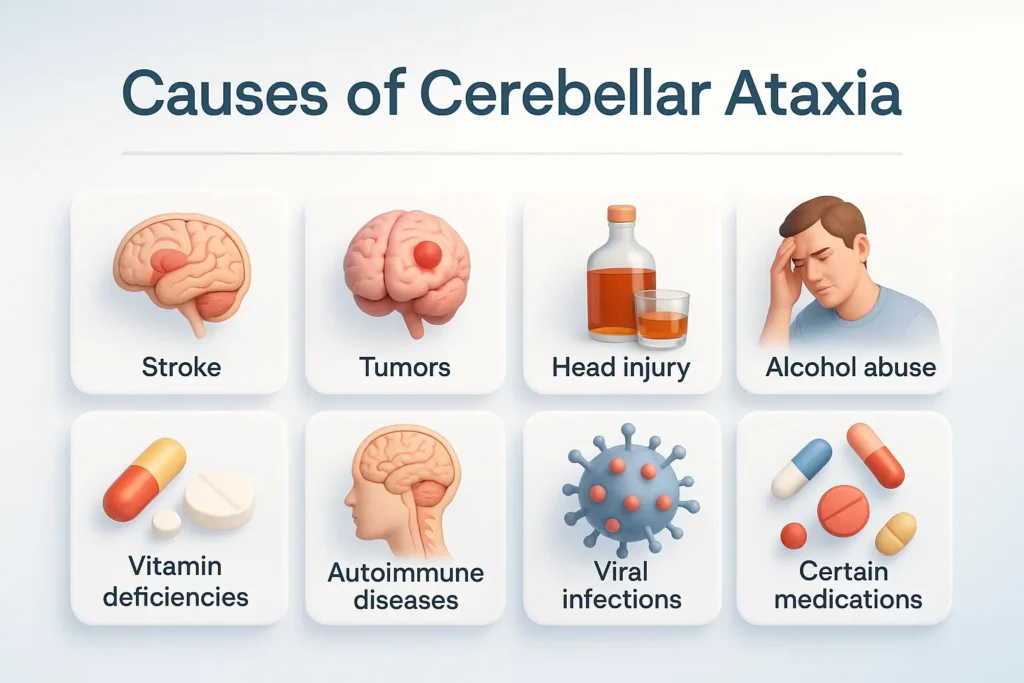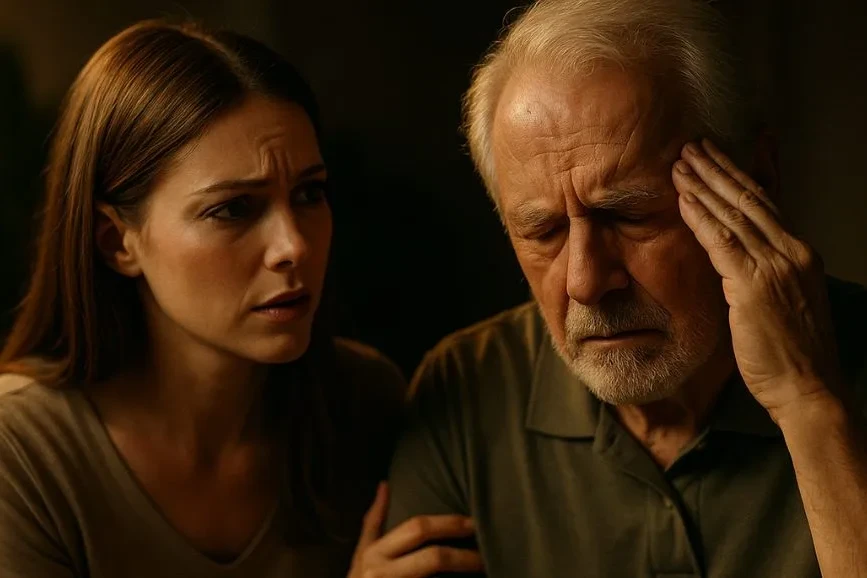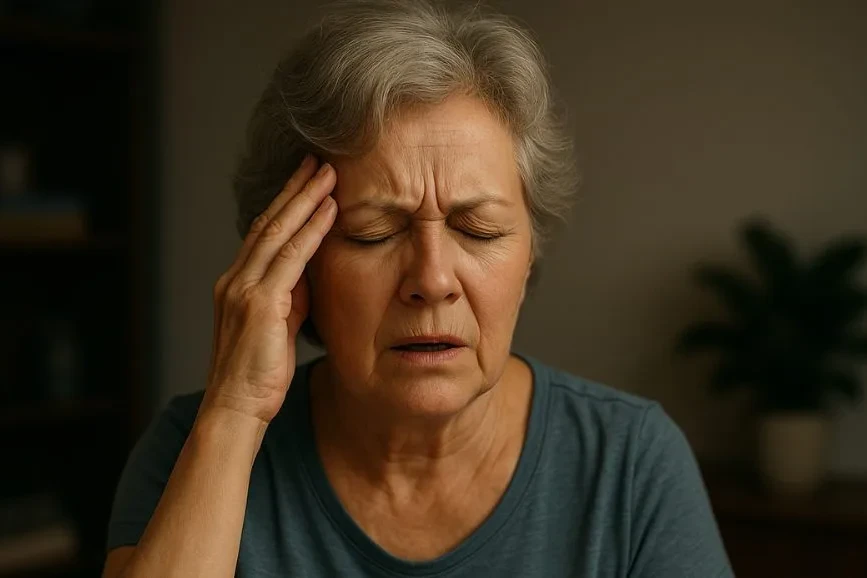Cerebellar ataxia refers to a condition in which your brain has difficulty managing balance, coordination, and speech. This is a clear indication that your nervous system requires assistance.
But what is cerebellar ataxia , really? When your brain’s control center misfires, your body stops listening and loses control over movement.
If you want the real, clear cerebellar ataxia definition without confusing terms, keep reading. You’ll learn what causes it, how it shows up, and what you can do about it.
Table of Contents
ToggleWhat is cerebellar ataxia?
What is cerebellar ataxia in simple words? Cerebellar ataxia is when your brain can’t properly control your body movements. The part of your brain responsible for balance, called the “cerebellum”, stops working as it should. That’s the root of the problem. And that’s the core of cerebellar ataxia meaning .
So what happens when the cerebellum is damaged?
You start feeling off-balance. Your hands may shake. You may speak slowly. Even walking straight becomes hard.

Now let’s break down the cerebellar ataxia definition even more:
- “Cerebellar” = The back portion of the brain that regulates coordination
- “ Ataxia ” = Lack of muscle control
When combined, cerebellar ataxia refers to impaired coordination brought on by injury to the cerebellum.
This condition isn’t rare and it’s not the same for everyone. Some people are born with it. Some develop it after a stroke, injury, or illness. And some don’t know they have it until it slowly shows up in their everyday life.
If you’ve ever wondered what is cerebellar ataxia , it’s a brain-based condition that disrupts how you move, talk, and balance.
What are the symptoms of cerebellar ataxia?
Cerebellar ataxia symptoms can vary, but they mostly affect movement. Some symptoms include:
- Trouble with balance and walking
- Clumsiness when using hands
- Slurred or slow speech
- Eye movement issues
- Shaking in hands or arms
- Trouble swallowing
These signs of cerebellar ataxia may show up slowly or all at once. Sometimes, people also notice changes in writing, holding objects, or even simple tasks like buttoning a shirt.
Symptoms can change daily. They may be mild or very serious. And no two people feel the same way.
When to see a doctor?
If you or someone you care about starts having trouble walking, slurring words, or dropping things without reason, knowing when to see a doctor for cerebellar ataxia can make a real difference.
Here are early warning signs that should never be ignored:
- Repeated falls or walking unsteadily
- Hand tremors while doing simple tasks
- Eyes moving abnormally
These could be early signs of cerebellar ataxia or something more serious like a stroke.
Don’t assume it’s just weakness or tiredness. If these issues come on quickly, especially after an illness or head injury, get medical attention immediately.
Visiting a neurologist early on facilitates a faster cerebellar ataxia diagnosis and allows for timely treatment.
What causes cerebellar ataxia?
There are many cerebellar ataxia causes . Some people are born with it (genetic), while others develop it later (acquired).
Genetic causes:
- Spinocerebellar ataxias (inherited from parents)
- Friedreich’s ataxia
- Mitochondrial diseases
Acquired causes:
- Stroke
- Tumors
- Head injury
- Alcohol abuse
- Vitamin deficiencies (like B12 or E)
- Autoimmune diseases (like multiple sclerosis)
- Viral infections
- Certain medications (like chemotherapy or anticonvulsants)
In some, the cause is unknown. This is called “idiopathic ataxia.”
To determine the cause, doctors could require genetic testing, blood tests, and brain imaging. Knowing the cause helps with proper cerebellar ataxia management .
How long does cerebellar ataxia last?
It depends. Some cases are short-term and go away with treatment, like those from infections or vitamin issues. Others may gradually deteriorate and are permanent.
If it’s caused by stroke or trauma, you may see improvements in weeks or months. If it’s genetic, like in spinocerebellar ataxia, the condition may get worse over years.
There’s no one-size-fits-all answer. But with the right care, many people still live a full life. Timely intervention can help reduce symptoms and enhance everyday functioning.
How is cerebellar ataxia diagnosed?
Cerebellar ataxia diagnosis isn’t based on one test. Doctors use many steps.
- Check your balance, coordination, and speech during a physical exam
- Order a brain MRI or CT scan to spot cerebellum damage or stroke
- Do blood tests to check for vitamin deficiencies, autoimmune problems, or infections
- Encourage genetic testing if ataxia is inherited.
- At times, a lumbar puncture may be necessary to exclude brain infections or inflammation.
This helps doctors confirm the condition and rule out other problems. Early cerebellar ataxia diagnosis is key to starting the right cerebellar ataxia treatment .
What is the treatment for cerebellar ataxia?
There’s no magic pill for cerebellar ataxia , but real help exists. The goal of cerebellar ataxia treatment is to improve function, reduce symptoms, and slow progression.
Personalized therapy is key:
Your doctor will first identify the root cause. Is it genetic? From a stroke? From alcohol use? Based on that, the treatment changes.
Common cerebellar ataxia management options include:
- Physical therapy: Improves balance, walking, and posture. Cerebellar ataxia exercises are tailored to your needs. It has been demonstrated that regular movement slows the development.
- Speech therapy: Speech therapy can help if you have swallowing difficulties or slurred speech.
- Occupational therapy: Helps you do daily activities, like eating, dressing, or writing without losing independence.
- Medications: There are no drugs to cure it, but certain meds help control symptoms like tremors, stiffness, or depression.
- Nutritional support: A doctor might recommend a cerebellar ataxia diet rich in B12, Vitamin E, and antioxidants if deficiencies are involved.
- Balance devices: Walkers, braces, or weighted utensils reduce fall risk and support movement.
The best cerebellar ataxia treatment is one that’s built around your needs. And it must be reviewed regularly as the condition evolves.
Living with Cerebellar Ataxia
Living with cerebellar ataxia requires practical adjustments. It’s about managing symptoms and building a safe, structured life that supports independence.
Simple changes at home matter:
- Use railings, walkers, and sturdy furniture
- Avoid slippery floors and stairs
- Sit down while dressing or cooking
- Use a shower chair or raised toilet seat
Emotionally, you may feel frustrated, anxious, or even embarrassed. That’s normal. Many people with cerebellar ataxia struggle with mental health. Talking to a counselor or support group can help.
Eat well. Sleep enough. Stay active. These daily steps matter more than you think.
Lastly, involve your family. Don’t do it alone. Managing cerebellar ataxia is easier when you’re supported physically and emotionally.
Wrapping up
Cerebellar ataxia can change how you move, speak, and live. But with the right help, many still live meaningful lives.
If you or someone you love shows symptoms, don’t ignore them. Early care can slow it down. Talk to a doctor, ask questions, and keep learning.
Knowing the cerebellar ataxia definition is just step one. Staying informed gives you control.
Cerebellar ataxia FAQs
What is cerebellar ataxia?
It’s a brain condition that affects coordination. You may walk unsteadily, slur words, or have shaky hands. It’s caused by damage to the cerebellum.
Can cerebellar ataxia be cured?
There’s no cure for most types, but symptoms can be managed. Early treatment, physical therapy, and lifestyle changes help improve quality of life.
What is the most common cause of cerebellar ataxia?
Genetic conditions and strokes are common causes. Others include alcohol use, brain injury, vitamin deficiencies, or autoimmune diseases like multiple sclerosis.
How is cerebellar ataxia diagnosed?
Doctors use physical exams, brain scans, blood tests, and sometimes genetic tests. Diagnosis may take time and requires ruling out other conditions.
What is acute cerebellar ataxia?
It appears suddenly, usually after a viral infection, especially in children. It’s often short-term and may improve without treatment in a few weeks.
Is cerebellar ataxia hereditary?
Yes, many forms are inherited. If family members have similar issues, your doctor may recommend genetic testing to confirm a hereditary pattern.
How to test for cerebellar ataxia?
Doctors check your balance, movement, eye control, and speech. MRIs, blood tests, and genetic screenings help confirm cerebellar ataxia diagnosis.
Can children get cerebellar ataxia?
Yes, both inherited and acquired forms can affect children. Common causes include genetic mutations, infections, or brain injuries during growth.
What are the end stages of cerebellar ataxia?
In end stages of cerebellar ataxia, walking may stop completely, speech becomes hard, swallowing issues may need feeding support. 24/7 care may be necessary due to serious cerebellar ataxia complications.
About The Author

This article is medically reviewed by Dr. Chandril Chugh, Board-Certified Neurologist, providing expert insights and reliable health information.
Dr. Chandril Chugh is a U.S.-trained neurologist with over a decade of experience. Known for his compassionate care, he specializes in treating neurological conditions such as migraines, epilepsy, and Parkinson’s disease. Dr. Chugh is highly regarded for his patient-centered approach and dedication to providing personalized care.
→ Book a consultation to discover which remedies suit your needs best.





